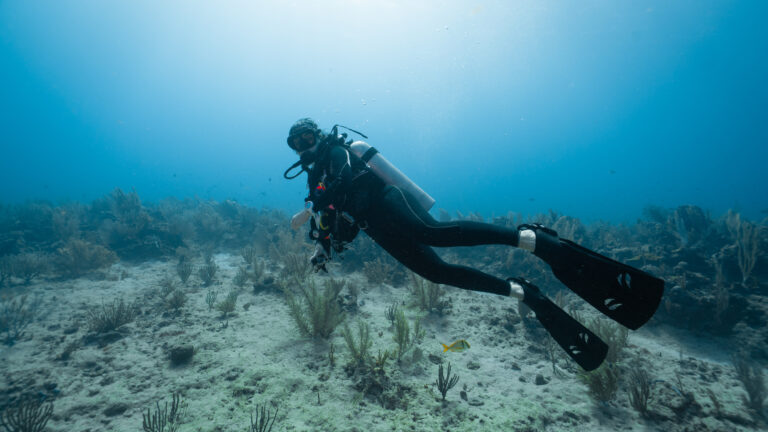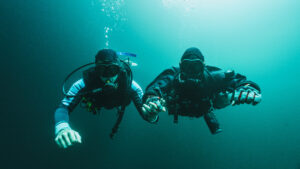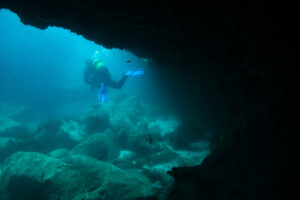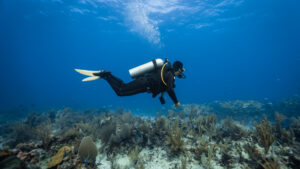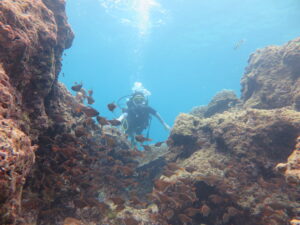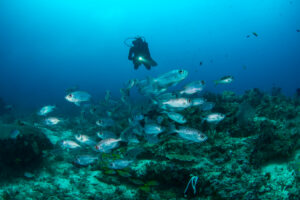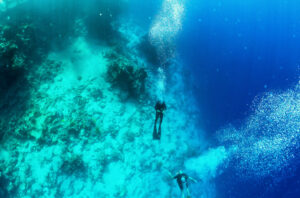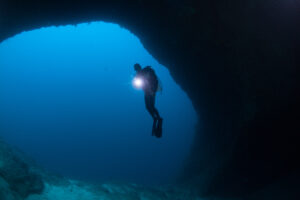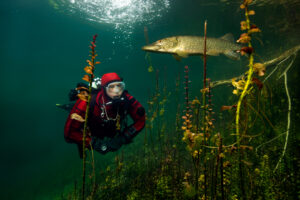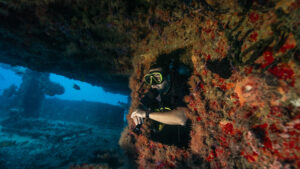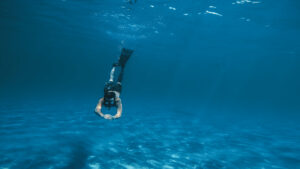What is Upwelling?
Upwelling is a critical oceanographic phenomenon where deep, cold, and nutrient-rich water rises to the surface, replacing the warmer, nutrient-depleted surface water. This process is vital to marine ecosystems as it brings essential nutrients like nitrate and phosphate to the photic zone, where sunlight can drive photosynthesis. Consequently, upwelling zones are often rich in marine life and are crucial for global fisheries. Scuba divers find these regions particularly interesting due to the diverse and abundant marine species supported by the nutrient influx. Understanding upwelling is fundamental for appreciating its ecological and economic significance.
The Science of Upwelling
The physical processes behind upwelling are primarily driven by wind and the Coriolis effect. When winds blow parallel to the coast, they move surface waters away from the shore due to the Ekman transport effect, causing deeper waters to rise. This process is especially prevalent along the western coasts of continents, such as the Pacific coast of South America, where the Humboldt Current brings cold water from the deep ocean to the surface. The temperature and density differences between the rising deep water and the existing surface water further facilitate the upwelling process.
Geographically, upwelling is most prominent in regions like the California Current, the Canary Current off Northwest Africa, and the Benguela Current off the southwest coast of Africa. These areas are characterized by nutrient-rich waters that support high primary productivity and significant fisheries. Seasonal variations also play a crucial role, with upwelling intensity often increasing during certain times of the year. For instance, in the Pacific Northwest, upwelling is strongest in the summer months when coastal winds are more favorable.
Seasonal variations in upwelling can be attributed to changes in wind patterns and ocean currents. During the summer, stronger and more consistent winds enhance the upwelling process, leading to increased nutrient availability and higher biological productivity. Conversely, in the winter, weaker winds and changes in ocean currents can reduce upwelling intensity, leading to a decline in nutrient levels and biological productivity. These seasonal cycles are crucial for maintaining the balance and health of marine ecosystems in upwelling regions.
Ecological Impacts of Upwelling
Upwelling significantly influences nutrient cycling and primary productivity in the ocean. The influx of nutrients stimulates the growth of phytoplankton, the base of the marine food web. These microscopic plants use sunlight and the nutrients brought by upwelling to grow and multiply, forming the foundation for a rich and diverse marine ecosystem. The abundance of phytoplankton, in turn, supports larger organisms, including zooplankton, small fish, and eventually, larger predatory fish, marine mammals, and seabirds.
Phytoplankton blooms, often observed in upwelling zones, are critical for supporting marine life. These blooms create feeding grounds for a wide array of marine species. Fish populations, including commercially important species like sardines and anchovies, thrive in upwelling areas due to the plentiful food supply. The presence of these fish attracts larger predators such as tuna, sharks, and marine mammals, creating a dynamic and vibrant ecosystem. The high biological productivity in upwelling regions makes them hotspots of biodiversity, with a multitude of species coexisting and interacting.
The biodiversity hotspots created by upwelling zones are essential for maintaining the health and resilience of marine ecosystems. These areas support complex food webs and provide habitat for a wide variety of species. Coral reefs, kelp forests, and seagrass beds often flourish in upwelling regions, contributing to the structural complexity and ecological richness of these environments. The intricate interactions between species in these biodiversity hotspots underscore the importance of upwelling in sustaining marine life and supporting the overall health of the ocean.
Economic and Environmental Significance
The economic significance of upwelling cannot be overstated. These regions are among the most productive fishing grounds globally, providing a substantial portion of the world’s fish supply. Fisheries in upwelling areas, such as those off the coasts of Peru and California, contribute significantly to local and global economies. The abundance of commercially valuable fish species like sardines, anchovies, and mackerel supports robust fishing industries and provides livelihoods for millions of people.
Local communities benefit economically from the rich fisheries supported by upwelling. These fisheries not only provide employment opportunities but also ensure a steady supply of food. Coastal communities often rely on fishing as their primary source of income, making the health and sustainability of upwelling zones crucial for their economic well-being. In addition to direct economic benefits, tourism related to recreational fishing and scuba diving in these biologically rich areas also contributes to local economies.
However, upwelling regions face environmental challenges and pressures. Overfishing is a significant concern, as the high productivity of these areas can lead to the overexploitation of fish stocks. Unsustainable fishing practices can deplete fish populations, disrupt food webs, and threaten the long-term viability of fisheries. Furthermore, climate change poses a threat to the stability of upwelling systems. Changes in wind patterns, ocean currents, and sea surface temperatures can alter the intensity and location of upwelling, impacting the availability of nutrients and the productivity of marine ecosystems.
Upwelling and Climate Change
Climate change is expected to affect upwelling patterns significantly. Alterations in global wind patterns, driven by climate change, can modify the strength and direction of coastal winds that drive upwelling. These changes may lead to shifts in the location and intensity of upwelling zones, with profound implications for marine ecosystems and fisheries. For example, if coastal winds weaken, the upwelling process may diminish, reducing the nutrient supply to surface waters and subsequently decreasing biological productivity.
Predicted shifts in upwelling intensity and location are of great concern to scientists and fisheries managers. Changes in upwelling can affect the distribution and abundance of marine species, potentially leading to shifts in fish populations and changes in the composition of marine communities. Such shifts can have cascading effects throughout the food web, impacting not only fish and marine mammals but also seabirds and human communities that rely on these resources.
The impacts of climate change on marine ecosystems extend beyond changes in upwelling patterns. Ocean acidification, rising sea temperatures, and changes in ocean currents all interact with upwelling processes, further complicating the picture. For example, increased ocean temperatures can stratify the water column, making it more challenging for upwelling to bring deep, nutrient-rich water to the surface. These combined effects underscore the need for comprehensive strategies to manage and mitigate the impacts of climate change on upwelling and marine ecosystems.
Upwelling in Scuba Diving
Scuba divers are particularly drawn to upwelling regions due to the unique and diverse underwater environments they create. The nutrient-rich waters support a wide variety of marine life, offering divers the opportunity to encounter numerous species in a single dive. In upwelling areas, divers can expect to see large schools of fish, vibrant coral reefs, and an abundance of invertebrates, making these sites popular destinations for underwater exploration.
However, diving in upwelling regions can present challenges. The cold, nutrient-rich water brought to the surface is often significantly colder than the surrounding water, requiring divers to wear appropriate thermal protection, such as thicker wetsuits or drysuits. Additionally, the strong currents associated with upwelling can make diving more challenging and require advanced diving skills and experience. Visibility can also be affected by the high concentrations of plankton and other suspended particles, which, while attracting marine life, can reduce the clarity of the water.
Notable upwelling diving sites around the world include the Galápagos Islands, the Channel Islands off California, and the coasts of Namibia and South Africa. These locations are renowned for their rich marine biodiversity and offer divers the chance to experience the vibrant ecosystems supported by upwelling. Divers in these regions can encounter everything from tiny invertebrates to large pelagic species, providing a thrilling and rewarding diving experience.
Key Takeaways
Upwelling is a vital oceanographic process that significantly impacts marine ecosystems and economies. By bringing nutrient-rich deep waters to the surface, upwelling supports high primary productivity and rich biodiversity, making these regions crucial for global fisheries and attractive for scuba divers. Understanding and preserving upwelling zones are essential for sustaining marine life and supporting the economic well-being of coastal communities in the face of environmental changes.

